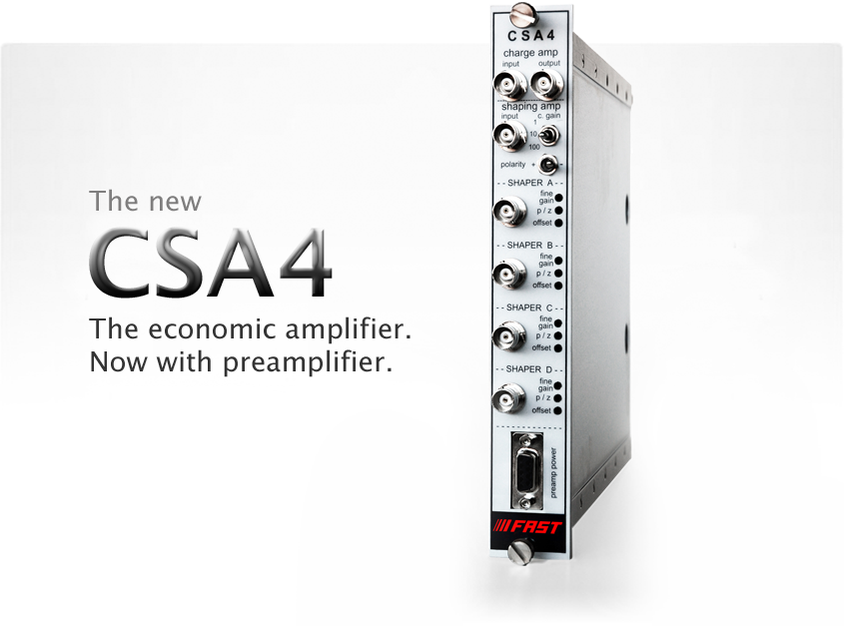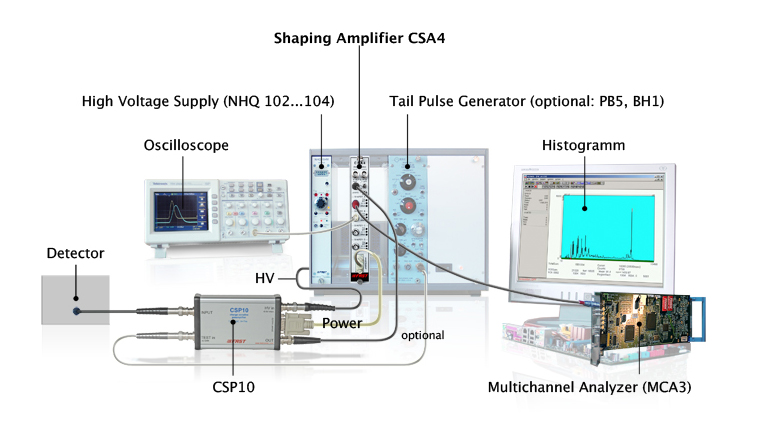CSA4 Charge / Shaping Amplifier

Functionally, the Model CSA4 provides in a single width NIM module an exceptional spectroscopy amplifier. The amplifier’s excellent stability, ultra low noise, broad gain range and wide choice of shaping time constants makes it ideally suited for applications involving Germanium, Silicon, Scintillation, Gas Proportional and Surface Barrier detectors.
FCT near-Gaussian filter shaping has been refined in the Model CSA4 for improved pulse symmetry, minimum sensitivity of output amplitude to variations in detector rise time, and maximum signal to noise ratio. For a given shaping time constant, the improved pulse symmetry minimizes the pulse dwell time by tucking in the trailing skirt of the unipolar pulse shape. This allows a faster return to the baseline. The result is superior energy resolution, count rate and throughput performance. Unipolar shaping is achieved with one differentiator and two active filter integrators. The differentiator is placed early in the amplifier to insure good overload recovery. The integrators are placed late to minimize noise contribution from the gain stages. Functionally, the Model CSA4 provides in a single width NIM module a preamplifier and a shaping amplifier with four shaping times simultaneously (selectable in the range from 100ns to 8μs: four values out of seven can be ordered : 100ns, 250ns, 500ns, 1μs, 2μs, 4μs, 8μs). A power connector (D-Sub 9 female) is also available at the front panel for the power supply of external preamplifiers. A front panel adjustable pole zero can be user trimmed to match the preamp fall time constant and minimize undershoot following the first differentiator for improved overload and count rate performance.
This section is not intended to serve as a complete list of applications. It is intended to identify some of the important features, and to indicate areas where they might be applied.
The Model CSA4 Spectroscopy Amplifier with its selection of shaping time constants allows it to be used in surface barrier, proportional counter, NaI ang Ge(Li) detector applications. The choice of shapings also allows the best possible performance by tailoring the system for the conflicting requirements of optimum signal to noise ratio and high count rate performance. The excellent stability and low noise contribution enhances the use of this amplifier in most applications.

Theory of operation
Charge sensitive preamplifiers are used when radiation is detected as a series of pulses, resulting in brief bursts of current flowing into or out of the preamplifier input. Depending on the type of detector, this burst of current may be very brief (<1 ns) or as long as a few μs. For an idealized detection current pulse taking the form of a delta function, the detected charge (time integral of the input current) will ideally take the form of a step function.
The output waveform of an actual charge sensitive preamplifier will of course have a non-zero rise time: for the CSP10 this figure is approximately 7 ns. Furthermore, capacitance at the preamplifier input (i.e. detector capacitance) will further slow the rise time at a rate of 0.4 ns / pF.
Keep in mind the output rise time will also be limited by the speed of the detector. For example, the detection current pulse from a CsI(Tl)/photodiode scintillation detector has a duration of approximately a couple μs, so the expected rise time of the charge sensitive preamplifier output will be at least that long.
The output waveform of the CSP10 using a capacitively-coupled fast square wave pulser at the input is shown below to the left. At long time domains, the output decays due to the discharge of the feedback capacitor through the feedback resistor, with an RC time constant of 140 μs. This decay of the output waveform is also shown below, to the right.

Specifications
(@ 20oC, ±12 volts, unloaded output)
Preamplification channels: 1
Equivalent noise charge (ENC)*:
ENC RMS: 200 electrons, 0.03 femtoCoul.
Equivalent noise in silicon: 1.7 keV (FWHM)
Equivalent noise in CdZnTe: 2.4 keV (FWHM)
ENC slope: 4 electrons RMS /pF
Gain: see table 1
Rise time**: 7 ns (see table 1)
Decay time constant: 140 μs (150 μs, 50 μs, 50 μs resp.)
Unsaturated output swing: -3 to +3 volts
Maximum charge detectable per event: (see table 1)
Power supply voltage (Vs): ± 12 volts nominal (± 2 volts)
Power supply current: < 10 mA
Power dissipation: < 240 mW
Operating temperature: -40 to +85 oC
Output offset: +0.2 to -0.2 volts
Output impedance: 50 ohms
Physical: Net weight: 250 gr.
Size without connectors: 126 mm x 80 mm x 30 mm
Size with connectors: 165 mm x 80 mm x 30 mm
* Measured with input unconnected, using Gaussian shaping amplifier with time constant =1 μs. With a detector attached to the input, noise from the detector capacitance, leakage current, and dielectric losses will add to this figure.
** Pulse rise time (defined as the time to attain 90% of maximum value) has a linear relationship with input capacitance. Value cited in the table assumes zero added input capacitance. Tocalculate pulse rise time for practical situations, use the equation: tr =0.4 Cd + 7 ns, where tr isthe pulse rise time in ns, and Cd is the added capacitance (e.g. detector capacitance) in pF. Keep in mind that others factors within the detection system may further limit this value.
